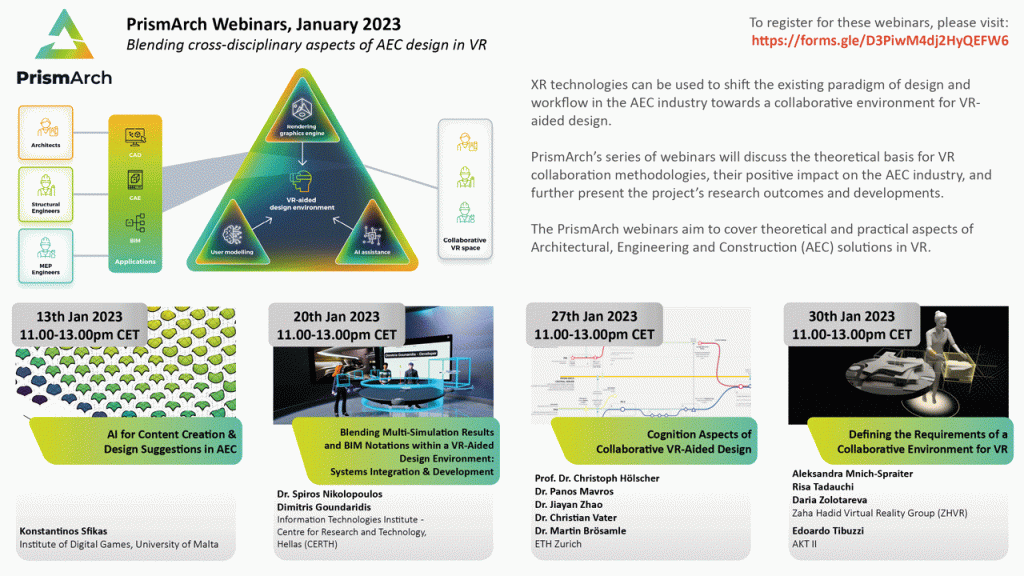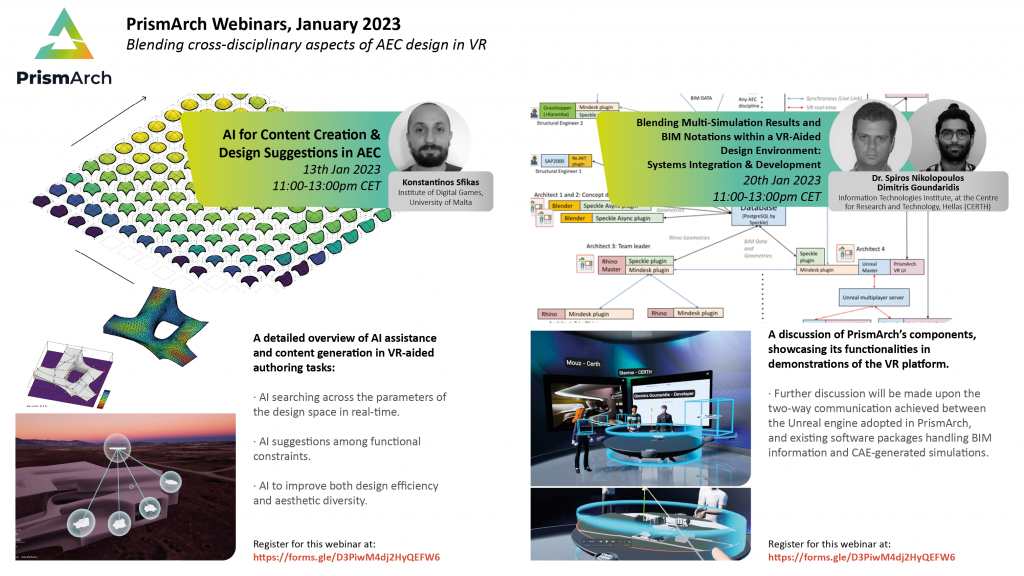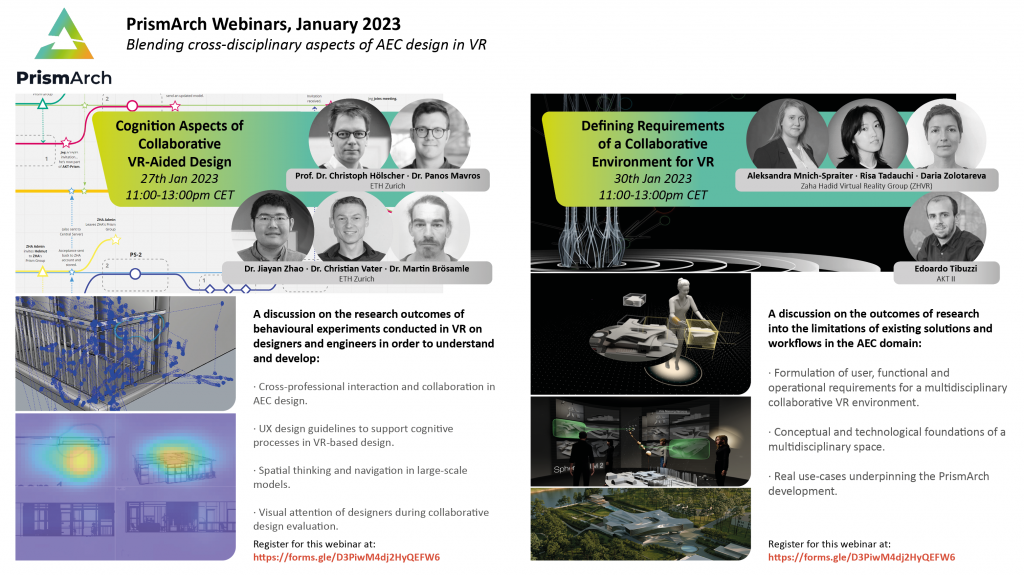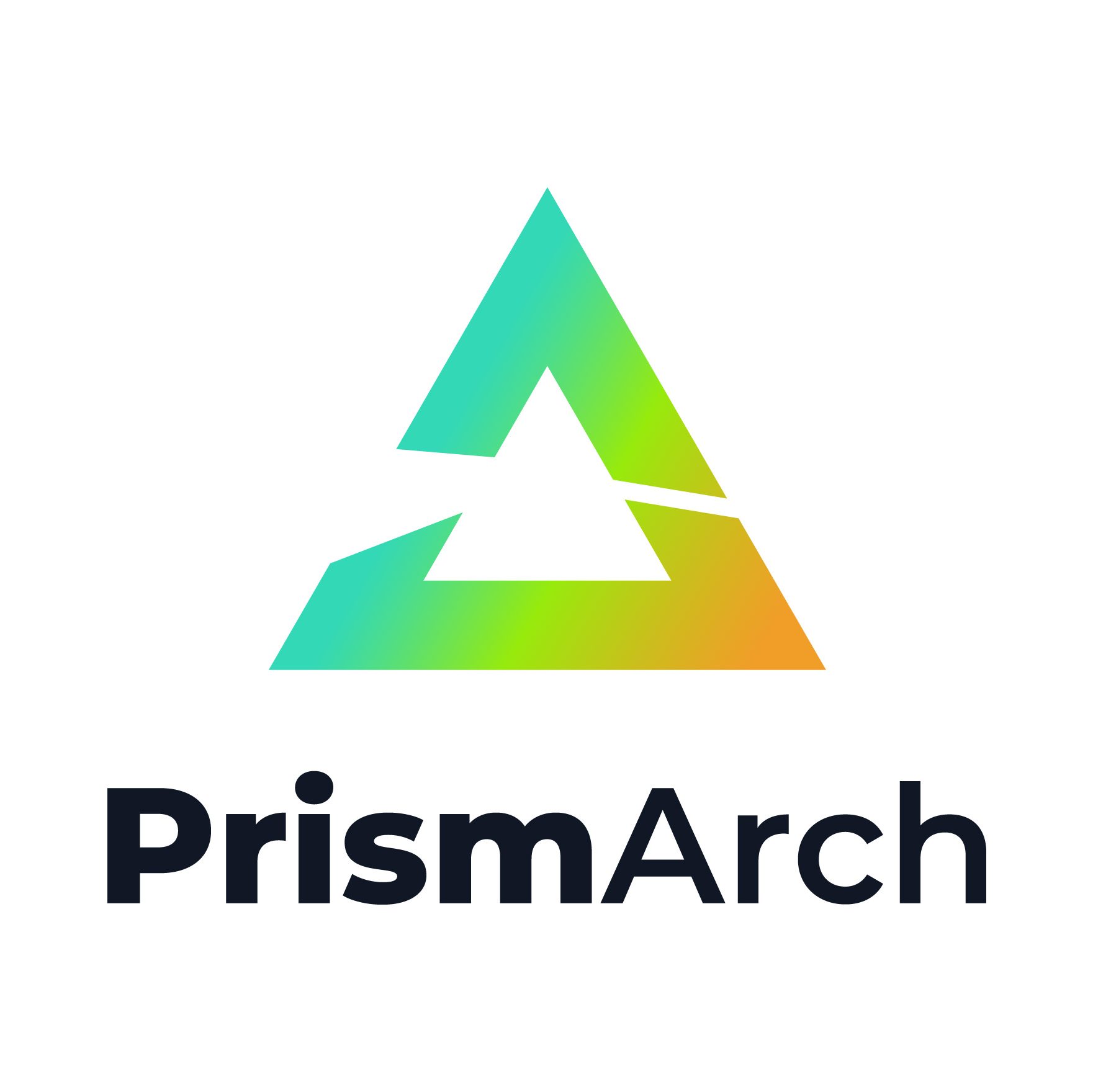PrismArch webinars series on January 2023

In the context of the PrismArch Horizon2020 project and its educational and informative activities, the PrismArch consortium has organized a series of 4 webinars in January 2023 to further diffuse the project’s developments, scientific background and research outcomes to all interested parties (AEC Industry, Software Companies, Investors, Research Communities and other stakeholders with an interest in AEC technologies).
Participants had the chance to register the webinar series and take part in the discussion of each topic. PrismArch series of webinars is also available online on our Youtube Channel providing more information on state of the art developments of XR technologies in AEC: PrismArch’s series of webinars discuss the basis for VR collaboration methodologies and their positive impact on the AEC industry in a variety of fields: AI, System Integration, Cognition aspects and User Requirements, aiming to cover theoretical and practical aspects of Architectural, Engineering and Construction (AEC) solutions in VR.
The PrismArch Project
PrismArch (virtual reality-aided design, blending cross-disciplinary aspects of architecture in a multi-simulation environment) is an H2020 research project that aims to create a VR-aided design environment for the AEC industry that will enhance the collaborative capabilities across all stakeholders and participating project disciplines (represented by the architectural, structural engineering and MEP disciplines for the purpose of this research). The “prismatic” composition of AEC project data will allow AEC professionals, clients, and stakeholders to quickly evaluate how their decisions affect the project, including the scope of other AEC disciplines. In order to achieve this ultimate goal that aims to disrupt the AEC industry with VR, PrismArch takes advantage of well-established technological advancements. By bridging the gap between a wide variety of domains such as computer graphics, computational physics, and cognitive science, and integrating them into a common workspace, PrismArch has developed a layered collaborative multi-simulation virtual environment, highly needed and currently missing from the AEC workflow in VR. Enhanced with AI-assistive capabilities, PrismArch meets the unique needs of each participating AEC profession’s workflows, while simultaneously facilitating multi-user and real-time collaboration within a high fidelity shared VR environment.
A brief overview of PrismArch’s challenges, objectives, pilots and main research outcomes can be found in the project’s concept video.
This project has received funding from the European Union’s Horizon2020 research and innovation programme under grant agreement No 952002.
Webinar Focus and Target Audiences
XR technologies can be used to shift the existing paradigm of design and workflow in the AEC industry towards a collaborative environment for VR-aided design. PrismArch’s series of webinars will discuss the theoretical basis for VR collaboration methodologies, their positive impact on the AEC industry, and further present the project’s research outcomes and developments.
The PrismArch webinars aim to cover theoretical and practical aspects of Architectural, Engineering and Construction (AEC) solutions in VR , addressing issues such as:
- User requirements of a multidisciplinary AEC VR environment
- System Integration and development of a VR-aided design environment
- AI for performance and viability optimization in AEC
- Cognition aspects of collaborative VR Environments
The webinars are addressed to:
- Software developers and students that wish to acquire additional knowledge in AEC technological solutions in VR.
- Professionals from AEC industry (Architects, Structural Engineers, MEP professionals) with an interest in new technologies in AEC and VR.
- Students in the AEC sector.
- Scientists engaged in AEC solutions and AI.
- Social scientists interested in cognition aspects of collaboration in VR.


Webinar Program at a Glance
4 webinars were organized between January 13th and 30th 2023 on a weekly basis, at 11:00 am CET (Brussels time). The duration of each webinar did not exceeded 2 hours. The presenters are experienced researchers and AEC professionals from the PrismArch consortium.
| Date | Webinar | |
| 1 | Friday, January 13th 11:00 a.m. – 13:00 p.m. CET | AI for Content Creation and Design Suggestions in AEC Tools and methods employed in the PrismArch platform for the AI assistive tools and the overall performance and viability optimization in AEC Konstantinos Sfikas (Institute of Digital Games, University of Malta) |
| 2 | Friday, January 20th 11:00 a.m. – 13:00 p.m. CET | Blending Multi-simulations Results and BIM Notations Within a VR-Aided Design Environment: System Integration and Development Presentation of the tools created in PrismArch Dr. Spiros Nikolopoulos Dimitris Gounaridis (Information Technologies Institute – Centre for Research and Technology Hellas) |
| 3 | Friday, January 27th 11:00 a.m. – 13:00 p.m. CET | Cognition Aspects of Collaborative VR-Aided Design Environments Discussion on cognitive, spatial, and navigational performance of users in collaborative virtual environments, as well as the ability to author, take decisions, and being productive in VR Prof. Dr. Christoph Hölscher, Dr. Panos Mavros, Dr. Jiayan Zhao, Dr. Christian Vater, Dr. Martin Brösamle (ETH Zurich) |
| 4 | Monday, January 30th (11:00 a.m. – 13:00 p.m. CET) | Defining Requirements of a Collaborative Environment for VR Aleksandra Mnich-Spraiter, Risa Tadauchi and Daria Zolotareva (Zaha Hadid Virtual Reality Group) Jeg Dudley (AKT-II) Dinos Ipiotis (SWECO) |
Webinar Videos, Extended Summaries & Useful Information
In the following, you can find useful info about the webinars’ focus (short summaries), presenters, target audiences, and useful educational material.
1. AI for Content Creation and Design Suggestions in AEC
This webinar provided the audience with a detailed overview of AI assistance and content generation in VR-aided authoring tasks. Among other, the audience will hear about AI assistance and content generation in VR-aided authoring tasks. In particular, AI searching across the parameters of the design space in real-time, presenting suggestions that satisfy functional constraints and both improve efficiency, aesthetic diversity, without causing item collisions and erroneous designs. Additionally, the webinar will discuss how the authoring procedure will be enhanced by user models, based on the needs of different disciplines and/or individual preferences.
Helpful material (PrismArch reports):
D2.1 Initial version of parametric design space
D2.2 Integration-ready version of AI algorithms to traverse the parametric solution space
2. Blending Multi-Simulations Results and BIM Notations Within a VR-Aided Design Environment: System Integration and Development
This webinar presented PrismArch’s components, showcasing its functionalities in demonstrations of the VR platform. Further discussion was made upon the two-way communication achieved between Unreal adopted in PrismArch and existing software packages handling BIM information and CAE-generated simulations.
Helpful material (PrismArch reports):
D4.1 Two-way communication protocol for interconnecting PrismArch with BIM/ CAE-Simulation software
D5.1 First version of architectural design and integration protocol
D5.2 First prototype of the VR-aided design platform
D5.3 Final revised version of architectural design and integration protocol
3. Cognition Aspects of Collaborative VR-Aided Design Environments
This webinar presented the research outcomes of the conducted behavioral experiments in VR on designers and engineers in order to measure the cognitive, spatial, and navigational stress induced, as well as the ability to author, take decisions, and being productive in the VR environment. The webinar also presented and discussed on the project’s outcomes and contribution in the general field of VR-aided authoring.
Helpful material (PrismArch reports):
D3.1 Report of cognitive issues in VR-aided design environments and usability guidelines
4. Defining Requirements of a Collaborative Environment for VR
This webinar presented the outcomes of research into the limitations of existing solutions and workflows in the AEC domain, leading to a formulation of user requirements, functional requirements, and operational requirements for a multidisciplinary collaborative VR environment. Presenters set out the conceptual and technological foundations of this multidisciplinary space and discussed on real use cases underpinning the PrismArch development, also sharing storyboards and mock-ups for a responsive VR environment and UI.
Helpful material (PrismArch reports and other supplementary reading):
ZHVR White Paper – Sphereing: A Novel Framework for Real-Time Collaboration and Co-Presence in VR
